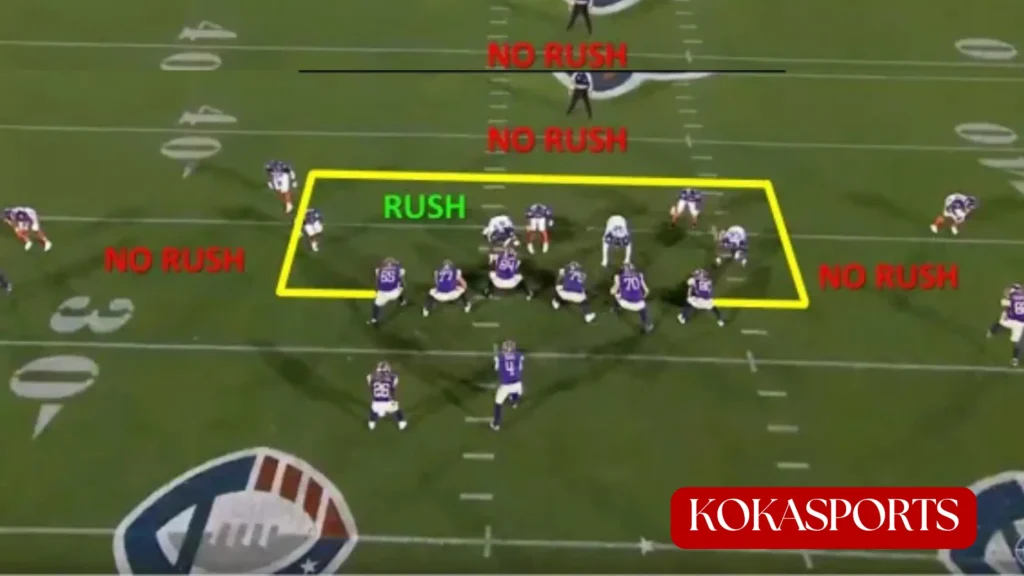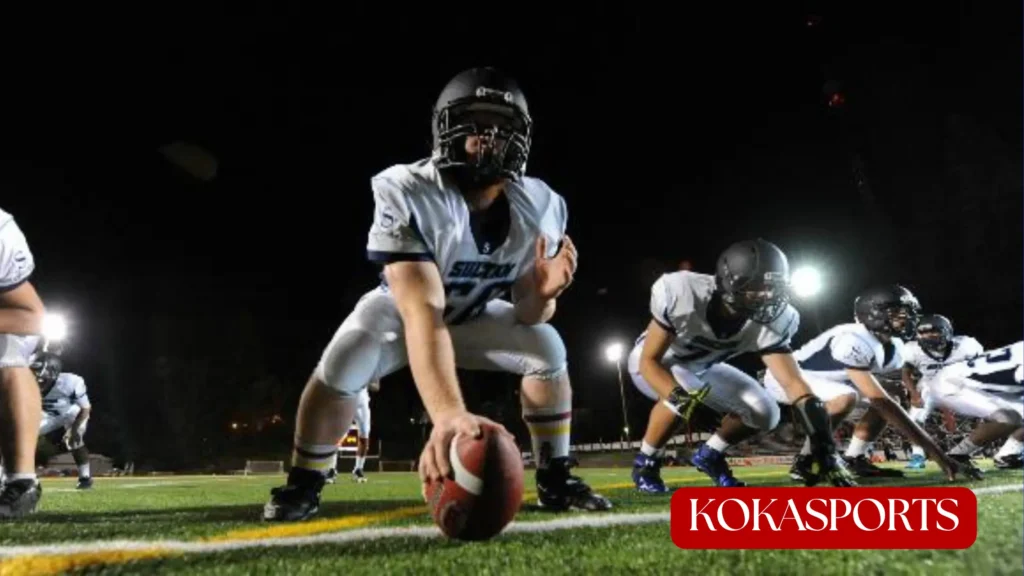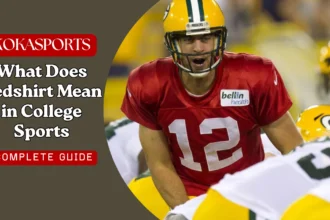When watching a football game, you might hear commentators mention “the tackle box” during crucial plays. This invisible zone on the football field plays a massive role in how plays develop and which penalties get called. Whether you’re a new fan trying to learn the game or a player looking to sharpen your knowledge, grasping this concept will help you appreciate the strategic depth of American football.
The tackle box serves as a critical reference point for referees when making calls about intentional grounding, blocking rules, and other important violations. It affects how quarterbacks make split-second decisions, how offensive linemen execute their blocks, and how defenders plan their attacks. This guide will walk you through everything you need to know about this essential area of the field, from its basic definition to advanced strategic applications.
The Basics – What Is the Tackle Box in Football?

The tackle box refers to an imaginary rectangular area on the field that stretches from the line of scrimmage backward toward the end zone. The width of this zone is determined by the positions of the two offensive tackles at the moment the ball is snapped. Picture a box drawn between these two players that extends all the way back through the quarterback’s position.
This area got its name simply because it’s defined by where the tackles line up. The offensive tackle positions on both sides the left tackle and right tackle create the boundaries. Everything between these two players, stretching backward, forms what we call the box in football. The line of scrimmage marks where the front of this zone begins, while it extends indefinitely toward the team’s own goal line.
Referees determine where this zone exists by watching where the tackles position themselves before each play. Once the play starts, this boundary stays fixed based on those initial positions, even if players move around. This matters because several football rules depend on whether certain actions happen inside or outside this specific area.
Read More: NFL Team Logos with Names :Complete Guide to Every NFL Team and Logo History
Where Is the Tackle Box in Football?
On any given play, you can visualize the tackle box by finding the two players at the ends of the offensive line these are your tackles. Draw imaginary vertical lines straight back from each of them. The space between those two lines, from the line of scrimmage back toward your own goal, creates this protected zone.
For example, if the offensive line spreads wider, the box gets wider. If the tackles line up closer together in a tight formation, the box shrinks. This flexibility means the box changes size from play to play based on the team’s formation. Referees must quickly identify these boundaries on every snap to make accurate calls.
The quarterback typically starts within this zone, positioned several yards behind the line of scrimmage. The center, guards, and tackles all work within or along the edges of this area, creating a protective pocket for passing plays.
What the Tackle Box Represents
From a strategic standpoint, within the tackle box defines where certain actions are legal or illegal. This zone represents the core area where the offensive team builds its protection schemes and where most power running plays occur. It’s where the offensive linemen create a fortress to protect the quarterback and open running lanes.
The box also helps differentiate between different types of plays. When a running back carries the ball through this area, we call it running “between the tackles.” When a quarterback scrambles outside of the pocket, he’s leaving this protected zone, which changes what he’s allowed to do with the football.
The Role of the Tackle Box in American Football Rules
Several major penalties and rules hinge on whether a player’s actions occur inside or outside this zone. The most famous involves the quarterback trying to throw the ball away under pressure.
The Tackle Box and Intentional Grounding
Intentional grounding happens when a quarterback deliberately throws an incomplete pass to avoid losing yardage, without a realistic chance of completing it to a receiver. However, the rules treat this differently depending on where the QB stands when throwing.
Inside the tackle box: If the quarterback stays within this zone and throws the ball away with no eligible receiver nearby, the officials call intentional grounding. This results in a loss of down and a 10-yard penalty from where the QB threw the ball. The reasoning is simple the protected zone gives the quarterback enough shelter that he shouldn’t need to throw the ball away.
Outside the tackle box: When a quarterback scrambles outside this area and throws the ball beyond the line of scrimmage, he can legally throw it away as long as it travels past the line. This rule gives mobile quarterbacks an escape option when the play breaks down. By leaving the protection of the box, they’ve earned the right to avoid a sack by throwing the ball out of bounds.
Consider a championship game scenario: The QB drops back to pass, feels pressure from a defender, and steps to his right outside the tackle zone. He throws the ball toward the sideline past the first-down marker with no receivers nearby. This is legal. But if he stayed between the tackles and made the same throw, the referee throws a flag for intentional grounding.
The Tackle Box and Blocking Rules
Blocking rules become particularly important when discussing block below the waist regulations. The NFL and college football have strict rules about when and where players can execute low blocks.
Inside the tackle box: Offensive players can generally block below the waist within this zone during running plays, as long as they’re engaging defenders in front of them. The lineman executing these blocks must be careful about hitting from the side or back, which remains illegal.
Outside the tackle box: Once players move beyond these boundaries, blocking below the waist becomes much more restricted. An offensive player who starts inside the box but leaves it cannot then execute a low block. This protects defenders from dangerous surprise hits to their legs.
For offensive players, knowing where the boundaries exist helps them stay within legal blocking zones. Guards and tackles work together to maintain clean blocking angles while staying aware of these restrictions. A tight end might start within the box but release outside it, which changes what blocking techniques he can use if he comes back to help on the play.
The Tackle Box and Pass Protection
The five offensive linemen two tackles, two guards, and a center build their pass protection schemes around maintaining the integrity of this zone. Their goal is keeping defenders from collapsing the pocket and getting to the quarterback. When football coaches design protection schemes, they assign responsibility for each gap within this area.
Defenders aim to penetrate this zone through various techniques. Defensive linemen might use power moves to push offensive tackles backward, shrinking the clean pocket space. Linebackers might time their blitzes to shoot through gaps between blockers. The constant battle over controlling this space defines much of football’s trench warfare.
Tackle Box and Offensive Strategy
Smart offensive coordinators use the tackle box as a foundation for designing plays. They know which actions are legal within the box versus outside it, and they construct their playbook accordingly.
Running Plays Inside the Tackle Box
When teams need short yardage or want to establish physical dominance, they often call runs “between the tackles.” This means the ball carrier receives the handoff and attacks the defense through the interior of the offensive line, staying within the tackle box boundaries.
These power runs rely on the offensive line winning battles directly against defensive linemen. Guards and tackles execute drive blocks, pushing defenders backward to create running lanes. The tight end might motion into this area to add an extra blocker, giving the offense more players in the box than the defense can match.
Defenses respond by stacking the box bringing extra defenders in the box like linebackers or safeties to stop the run. When defensive coordinators see formations suggesting a running play, they commit extra resources to this area. The battle becomes a numbers game, with each team trying to gain an advantage within these boundaries.
Passing Plays and the Tackle Box
For passing plays, the quarterback’s location relative to these boundaries determines his options. Pocket passers prefer staying within the protected zone, where they can step up between their tackles and throw a forward pass with a clear view downfield.
However, designed rollouts intentionally move the quarterback outside this area. These plays give mobile quarterbacks the option to run if coverage looks good downfield, or to throw the ball away legally if pressure arrives. A wide receiver might run a route toward the sideline, giving the scrambling quarterback a target, but if the receiver gets covered, the QB can sail the ball out of bounds without penalty.
Play-action passes often keep the quarterback inside the tackle box initially, using the run fake to freeze linebackers. The QB might then step outside the boundaries after the fake, giving himself running options while keeping the ability to avoid a sack by throwing the ball away safely.
Offensive Linemen Responsibilities in the Tackle Box
The five offensive linemen define where this zone exists through their alignment. Before each snap, their positioning sets the boundaries. The left tackle and right tackle mark the width, while the center, left guard, and right guard work within this space.
Each lineman has specific responsibilities based on the play call. On passing downs, they might form a cup around the quarterback, maintaining a clean pocket. On running plays, they might work combination blocks, with two linemen working together to control a single defender before one releases to the second level.
Formation shifts can change the box dimensions slightly. If the offense motions a tight end from one side to the other, it doesn’t change where the tackles line up, but it might affect how the defense adjusts their own players in the box.
Defensive Strategies Against the Tackle Box

Defensive coordinators study how offenses use this zone to attack it effectively. Their goal involves disrupting the clean pocket and forcing the quarterback to make uncomfortable decisions.
Defender strategies include:
- Penetrating gaps: Defensive tackles aim to shoot gaps between offensive linemen, getting into the backfield quickly
- Edge pressure: Defensive ends work to beat offensive tackles with speed or power moves around the outside
- Interior collapse: Multiple defenders push the middle of the line backward, shrinking the clean pocket
- Delayed blitzes: Linebackers time their rushes to arrive just as the quarterback sets to throw
A successful defense forces the quarterback to leave the pocket, either scrambling to avoid pressure or getting sacked behind the line of scrimmage. When the QB scrambles outside the boundaries, defenders must maintain discipline some pursue the scrambler while others stay in coverage to prevent easy completions.
Penalties and Common Mistakes Related to the Tackle Box
Intentional Grounding
This penalty occurs most frequently during obvious passing situations when quarterbacks face unexpected pressure. New quarterbacks often forget that staying inside the tackle box limits their ability to throw the ball away. They must either throw a forward pass toward an eligible receiver or accept the sack.
Veteran quarterbacks develop awareness of their position relative to the boundaries. They know exactly when they’ve stepped outside the zone and gained the freedom to throw the ball away safely. Officials watch the quarterback’s feet position at the moment of release to make this judgment call.
Illegal Block Below the Waist
This penalty protects player safety by preventing dangerous low blocks in vulnerable situations. An offensive player who starts within the tackle box but drifts outside it cannot then execute a low block. The rules require players to maintain awareness of their position throughout the play.
High school football, college football, and the NFL all enforce variations of these rules. Generally, blocks aimed at or below the waist become increasingly restricted as players move away from the initial point of attack. This prevents devastating hits on defenders who don’t see the blocker coming.
How Officials Identify the Tackle Box in Real Games
Referees use simple visual markers to identify boundaries during live action. They watch where the two offensive tackle positions line up before the snap. Mental or physical notes establish these boundary lines for the upcoming play.
Side judges and back judges position themselves to watch whether quarterbacks stay within or leave this zone. They communicate through signals and eye contact with the head referee. When a potential intentional grounding situation develops, the officials quickly determine the quarterback’s location before making the call.
The officiating crew discusses borderline situations between plays. If a quarterback appeared close to the boundary line when throwing, officials might conference briefly to get the call right. The stakes are high a wrong call on intentional grounding in the end zone results in a safety, giving the defensive team two points.
Evolution of the Tackle Box in American Football
This rule concept developed as passing became more prominent in football strategy. Early football featured mostly running plays, so the distinction between inside and outside this zone mattered less. As forward passing became central to the game, rules evolved to balance quarterback protection with defensive fairness.
Modern spread offenses complicate how officials identify these boundaries. When teams line up with only one tight end or use empty backfields, the tackles might set wider apart than traditional formations. This creates a wider zone, giving quarterbacks more space to operate before they’re considered outside the pocket.
The NFL and college football maintain similar tackle box rules, though some specific penalty yardages differ. Both levels use this concept for intentional grounding calls and blocking restrictions. High school football follows similar principles but sometimes adjusts specific applications to match the skill level and safety needs of younger players.
Summary : Why Every Player Should Understand the Tackle Box
Every position player benefits from knowing how this zone affects their responsibilities. Quarterbacks must track their position to avoid intentional grounding penalties. Offensive linemen need to maintain proper blocking techniques within legal zones. Receivers and tight ends should recognize when they’re the nearest eligible player to prevent grounding penalties on broken plays.
For defensive players, recognizing when opponents operate inside versus outside this area helps them anticipate play developments. A defender who sees the quarterback scrambling outside the boundaries knows he might attempt to throw the ball away. Defensive coordinators design pressures specifically to push quarterbacks outside the comfort zone or force them into situations where they must take sacks.
The tackle box represents one of those football concepts that seems simple on the surface but reveals layers of strategic depth the more you study it. It affects nearly every play from scrimmage, influencing decisions by all 22 players on the field. Coaches spend hours teaching these concepts because proper execution separates winning teams from losing ones.
Conclusion:
This invisible zone on the football field serves as a critical reference point for rules, penalties, and strategic decision-making. From intentional grounding calls to blocking rules to overall offensive and defensive strategies, the tackle box influences how football gets played at every level.
As you watch your next game, try identifying where this zone exists on each play. Watch how quarterbacks position themselves relative to it, how offensive linemen work to maintain its integrity, and how defensive players attack it. Notice when area of the field commentators mention “outside the pocket” or “between the tackles” they’re referencing this exact concept.
The more you recognize these patterns, the more you’ll appreciate the chess match happening on every snap. Players who master tackle box concepts gain competitive advantages through knowledge and awareness. Whether you’re playing, coaching, or just enjoying the game from the stands, this knowledge enriches your football experience.
FAQs
What is a tackle box?
A tackle box in football is the area between the two offensive tackles extending backward to the quarterback.
What is the box in football?
The box in football refers to the space near the line of scrimmage where most offensive and defensive linemen line up.
What is tackle in football?
A tackle in football is when a defensive player stops the ball carrier by bringing them to the ground.
Why are they called tackle boxes?
They’re called tackle boxes because the area is defined by the positions of the offensive tackles on each side of the line.




